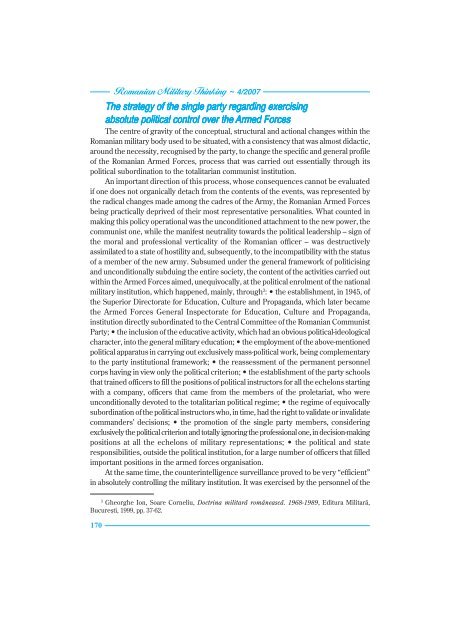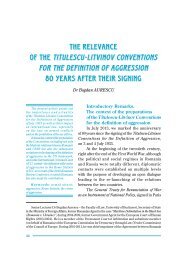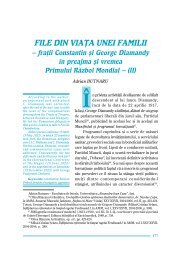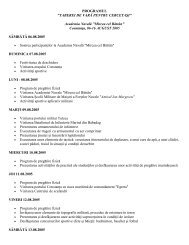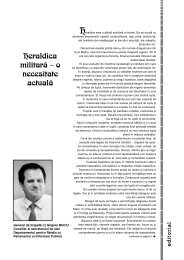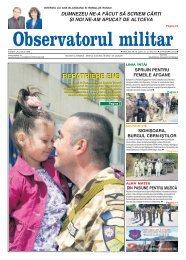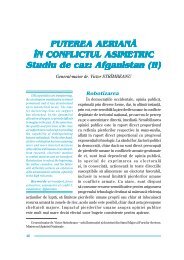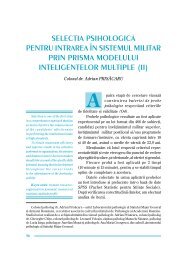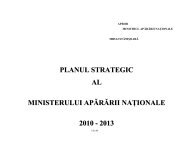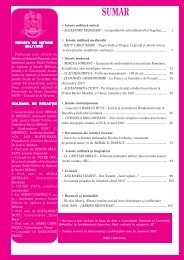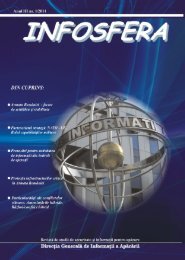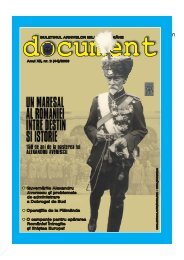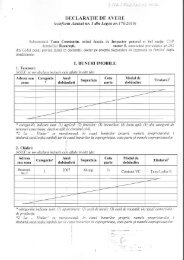Romanian Military Thinking
Romanian Military Thinking
Romanian Military Thinking
Create successful ePaper yourself
Turn your PDF publications into a flip-book with our unique Google optimized e-Paper software.
170<br />
<strong>Romanian</strong> <strong>Military</strong> <strong>Thinking</strong> ~ 4/2007<br />
The The The The The strategy strategy strategy strategy strategy of of of of of the the the the the single single single single single party party party party party regarding regarding regarding regarding regarding exercising exercising exercising exercising exercising<br />
absolute absolute absolute absolute absolute political political political political political control control control control control over over over over over the the the the the Armed Armed Armed Armed Armed Forces Forces Forces Forces Forces<br />
The centre of gravity of the conceptual, structural and actional changes within the<br />
<strong>Romanian</strong> military body used to be situated, with a consistency that was almost didactic,<br />
around the necessity, recognised by the party, to change the specific and general profile<br />
of the <strong>Romanian</strong> Armed Forces, process that was carried out essentially through its<br />
political subordination to the totalitarian communist institution.<br />
An important direction of this process, whose consequences cannot be evaluated<br />
if one does not organically detach from the contents of the events, was represented by<br />
the radical changes made among the cadres of the Army, the <strong>Romanian</strong> Armed Forces<br />
being practically deprived of their most representative personalities. What counted in<br />
making this policy operational was the unconditioned attachment to the new power, the<br />
communist one, while the manifest neutrality towards the political leadership – sign of<br />
the moral and professional verticality of the <strong>Romanian</strong> officer – was destructively<br />
assimilated to a state of hostility and, subsequently, to the incompatibility with the status<br />
of a member of the new army. Subsumed under the general framework of politicising<br />
and unconditionally subduing the entire society, the content of the activities carried out<br />
within the Armed Forces aimed, unequivocally, at the political enrolment of the national<br />
military institution, which happened, mainly, through 3 : • the establishment, in 1945, of<br />
the Superior Directorate for Education, Culture and Propaganda, which later became<br />
the Armed Forces General Inspectorate for Education, Culture and Propaganda,<br />
institution directly subordinated to the Central Committee of the <strong>Romanian</strong> Communist<br />
Party; • the inclusion of the educative activity, which had an obvious political-ideological<br />
character, into the general military education; • the employment of the above-mentioned<br />
political apparatus in carrying out exclusively mass-political work, being complementary<br />
to the party institutional framework; • the reassessment of the permanent personnel<br />
corps having in view only the political criterion; • the establishment of the party schools<br />
that trained officers to fill the positions of political instructors for all the echelons starting<br />
with a company, officers that came from the members of the proletariat, who were<br />
unconditionally devoted to the totalitarian political regime; • the regime of equivocally<br />
subordination of the political instructors who, in time, had the right to validate or invalidate<br />
commanders’ decisions; • the promotion of the single party members, considering<br />
exclusively the political criterion and totally ignoring the professional one, in decision-making<br />
positions at all the echelons of military representations; • the political and state<br />
responsibilities, outside the political institution, for a large number of officers that filled<br />
important positions in the armed forces organisation.<br />
At the same time, the counterintelligence surveillance proved to be very “efficient”<br />
in absolutely controlling the military institution. It was exercised by the personnel of the<br />
3 Gheorghe Ion, Soare Corneliu, Doctrina militar` româneasc`. 1968-1989, Editura Militar`,<br />
Bucure[ti, 1999, pp. 37-62.


